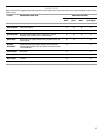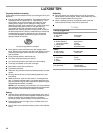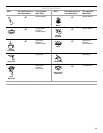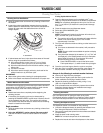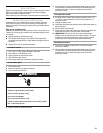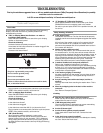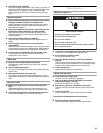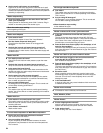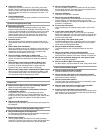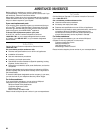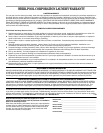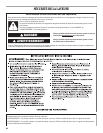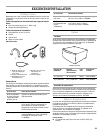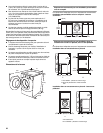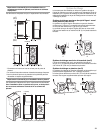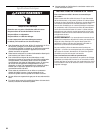
25
■ Is the drum empty?
Rotate drum by hand to check for any binding of the spin
basket. Check for clothing stuck between spin basket and
outer tub. Move open end drum up and down while holding
outer tub steady and check for looseness (more than ¼" of
movement).
■ Is the load balanced?
A single or bulky item may cause imbalance. Add more items
or redistribute the load.
Cycle time changes/Cycle too long
■ Estimated cycle time?
The cycle times vary automatically based on your water
pressure, water temperature, detergent, and clothes load. The
cycle time will be extended if oversudsing occurs or the load
is unbalanced. The SUDs routine removes extra suds and
assures proper rinsing of your garments. The options you
select will also affect the cycle times that are shown in the
Preset Cycle Settings table.
■ Excessive suds?
When excessive suds are detected, a special suds routine
automatically starts. This routine will add time to the original
cycle.
■ Did the load cause imbalance?
When an imbalance occurs, an imbalance routine will start to
redistribute the load. During the imbalance routine the time
displayed may pause until this activity is complete, then
resume with the remainder of the cycle.
■ Are you washing a single item or bulky load?
Spin time is added if an unbalanced load is detected. The
washer will attempt to redistribute the load with additional
tumbling.
■ Did you wash a large load on the Quick Wash cycle?
The Quick Wash cycle is designed for smaller load sizes
(2-3 items) of lightly soiled garments. If larger loads are
washed in this cycle, wash time will be increased.
■ Did you wash a large load in a Delicate/Hand Wash cycle?
When using the Quick Wash, or Delicate/Hand Wash cycles
you should use small loads. This ensures a gentle wash for
your garments without increasing cycle times.
Clothes Care
Load too wet
■ Did you use the right cycle for the load being washed?
Select a cycle with a higher spin speed.
■ Did you wash a single item or bulky items or have you
overloaded the washer?
A single item, bulky items, or overloading may cause
imbalance. Add items or try to evenly distribute your wet
laundry in the drum, and start a Drain/Spin cycle. If the laundry
is still wet, take half of the load out of the washer and try
again.
■ Did you use HE detergent?
Suds during rinse and spin cycles can reduce spin speed. Use
HE detergent.
Residue, lint, stains on load; gray whites, dingy colors
■ Did you add detergent to the dispenser?
For best results, add detergent to the detergent compartment.
Do not add detergent to the washer drum.
■ Did you sort properly?
Sort lint givers (towels, chenille) from lint takers (corduroy,
synthetics). Transfer of dye can occur when mixing whites and
colors in a load. Sort dark clothes from whites and lights.
■ Did you overload the washer?
Do not overload the washer. The washer can be fully loaded,
but not tightly packed. The wash load must be balanced. Lint
can be trapped in the load if overloaded.
■ Check the following:
Was paper or tissue left in pockets?
■ Did you use enough HE detergent?
Follow manufacturer’s recommendations for the type of load
you are washing. For best performance, use only High
Efficiency detergent.
Use enough HE detergent to remove soil
and hold it in suspension.
■ Do you have hard water?
Use more detergent for washing heavy soils in cold or hard
water.
■ Is your water colder than 60°F (15.6°C)?
Wash water colder than 60°F (15.6°C) may not completely
dissolve the detergent. Use hot or warm washes if safe for the
fabric load. Make sure your hot water system is adequate to
provide a hot water wash.
■ Are you using a low speed wash cycle?
Powdered detergents may not dissolve well in a slow-speed
cycle. For best results, use liquid detergent for slow-speed
cycles such as Delicate/Hand Wash.
■ Did you unload the washer promptly?
To avoid transfer of dye, unload the washer as soon as it
stops.
■ Did you use a fabric softener dispensing ball?
Dispensing balls will not operate correctly with this washer.
Add liquid fabric softener to the fabric softener compartment.
■ Did you use powdered detergent in a low-speed cycle?
Consider using liquid detergent.
■ Did you use Quick Wash on a large load?
For best results, use Quick Wash for small, lightly soiled loads.
Load is wrinkled, twisted, tangled
■ Did you unload the washer promptly?
Unload the washer as soon as it stops.
■ Did you use the right cycle for the load being washed?
Use the Delicate/Hand Wash cycle or another cycle with a low
spin speed to reduce wrinkling.
■ Did you overload the washer?
The wash load must be balanced and not overloaded. Loads
should tumble freely during washing.
■ Was the wash water warm enough to relax wrinkles?
If safe for load, use warm or hot wash water.
■ Are the hot and cold water hoses reversed?
Check that the hot and cold water hoses are connected to the
right faucets. A hot rinse followed by spin will cause wrinkling.
See “Connect the Inlet Hoses.”



